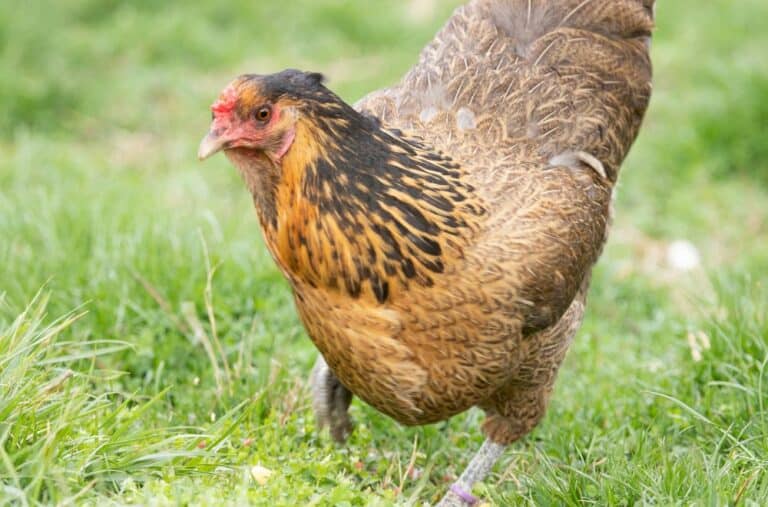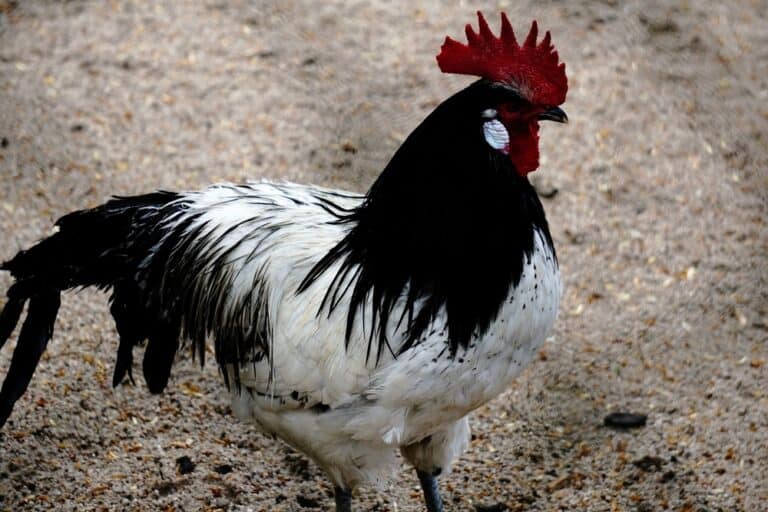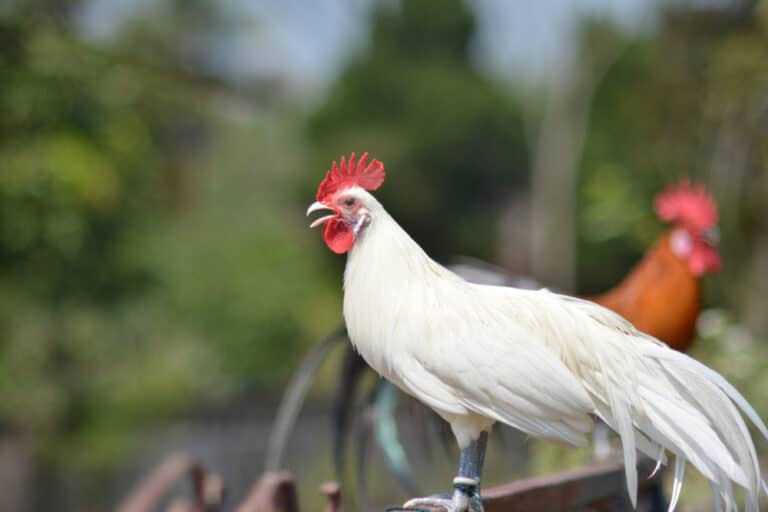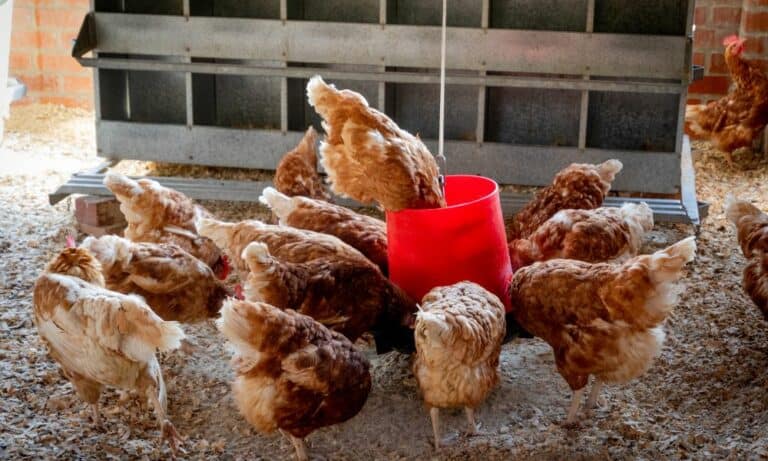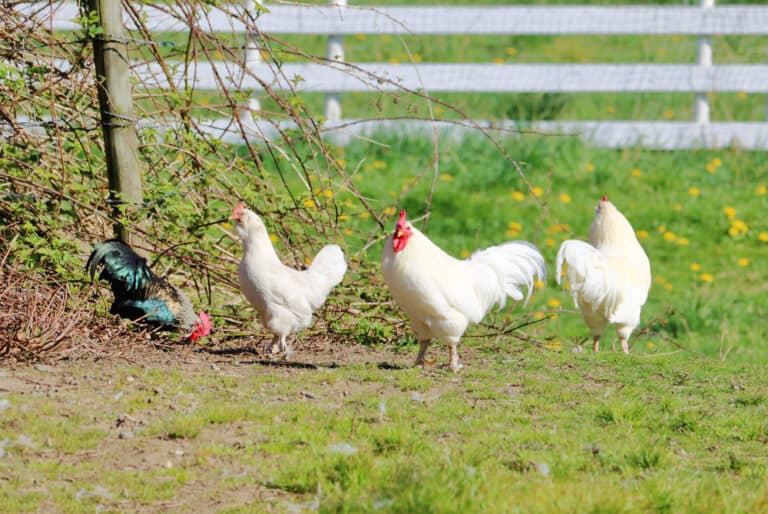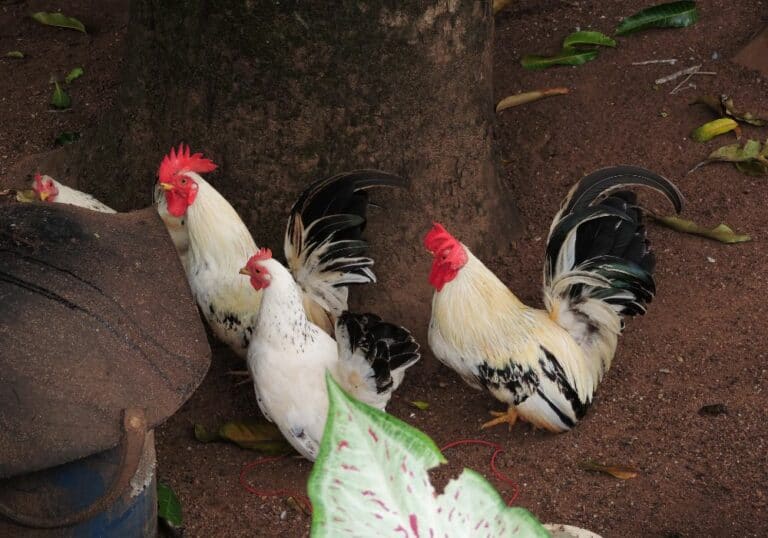Mosaic chicken is a fairly old breed. Poultry enthusiasts claim there is evidence for the existence of this chicken breed from the 1780s.
However, it is only recently that this chicken breed gained popularity in Europe and the USA. And currently, the charm of these chickens is the talk of the town!
There’s a high chance you’ve heard some stories too. But you can’t be sure whether you’ve heard the truth or not, because the recently built-up excitement and chatter around the breed have fogged the facts.
In this post, we bring you the absolute crystal clear truth about the mosaic chicken. We’ll explore Mosaic’s personality, unique traits, basic needs, and much more!
General Overview: Mosaic Chickens
| Origin | USA (disputed history about the origin) |
| Skin Color | Bluegreen or blue skin |
| Feather Color | Black, white, yellow, blue, and various patterns |
| Average weight | 6-8 lbs |
| Lifespan | 3-5 years |
| Size | Medium |
| Comb Type | Single |
| Distinct Feature | Mosaic feather pattern and turquoise earlobes |
| Temperament | Calm and gentle |
| Noise level | Moderate |
| Egg Color | Cream |
| Egg Size | Medium |
| Egg Production | Moderate (200 – 250 eggs per year) |
| Broodiness | Moderate |
| Weather Tolerance | Heat-hardy |
| Confinement Tolerance | Good |
| Flock Tolerance | Good |
| Ability to Sense Threats & Predators | Great |
History & Origin of Mosaic Chicken
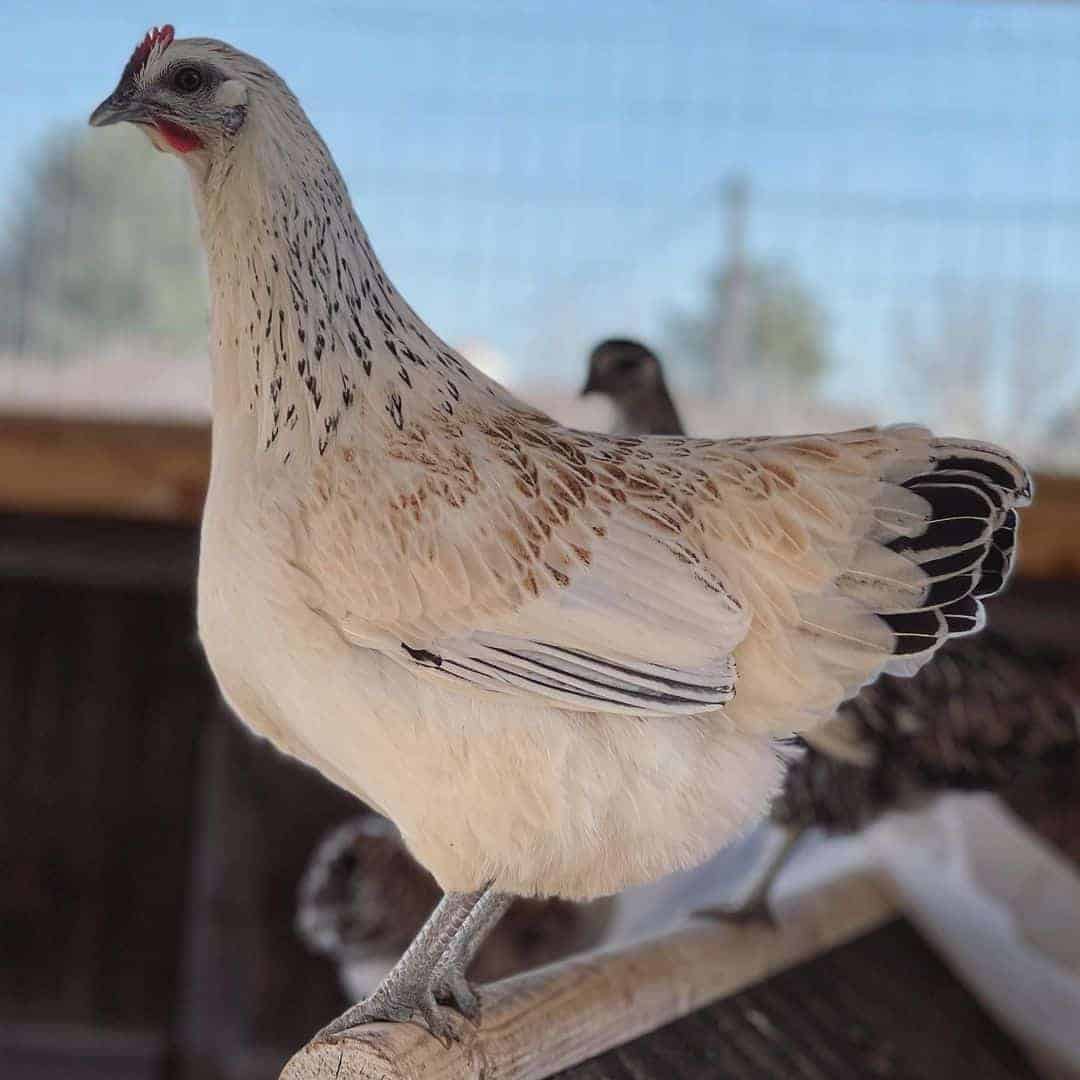
As mentioned earlier, some poultry enthusiasts claim that the mosaic chicken is a few hundred years old. They say that the first chicken of this breed appeared in North America in the 1780s – when they were brought to Ellis Island from England and France.
However, the majority claims that the mosaic chicken breed was a product of selective breeding at the Gold Feather Farms. Since this farm was founded only a few years ago, the mosaic chickens are no longer than a few decades old.
Given the disputed origin, there is no prominent historical significance, artifact, or event linked to this chicken breed. But one thing’s for sure, the mosaic chicken is a cross. It’s a mixture of different fibromelanistic chickens like Ayam Cemani, Silkie, Kadaknath, Hmong, and Ulikba.
Over time, the original mosaics were bred with other different breeds as well. Hence, patterns of some of the most recent varieties also resemble Campine and Braekel.
And this, in turn, gives these interesting birds their most unique aspect; each chicken has a distinctive appearance. Read more about their looks below!
What does a Mosaic Chicken look like?
Typically, a mosaic chicken is a cross between chickens with fibromelanosis, which is a condition affecting the pigmentation of a chicken’s skin. It turns the skin, bones, and meat of the chicken black.
Here’s what a chicken with fibromelanosis looks like:
Now, for a mosaic chicken, this resulted in hyperpigmentation. Some parts of a mosaic chicken are black, such as the feet and legs. Most mosaic chickens also have black in their plumage and combs.
You might expect mosaic chicken to have black skin too. But that’s not the case! These chickens usually have a blue-green or rich blue skin color (yep, it’s a sick tint!)
It’s worth noting that each mosaic chicken has a differently patterned plumage. So much so, it’s difficult to predict their coats’ color combinations based on their parents’ appearance. Plus, you might not even be able to find two birds that look exactly the same!
The base color of these beautiful chickens ranges from white to deep brown. There’s another color that tops the feathers’ base color and it’s usually black. But it can also be gray, brown, blue, and yellow.
The top color is sometimes spangled, sometimes clustered, and sometimes spread. It may even appear as streaks or swirls on the base color. And hence, the top color is what gives the mosaic chicken its ‘mosaic-like’ appearance.
Apart from that, mosaic chickens carry a single comb. This makes it a perfect breed for hot climates. They can easily tackle hot seasons and keep their bodies fairly cool.
The mosaic breed can also deal well with cold temperatures. But they’re not as tolerant to cold as they are to heat. You might need to provide extra bedding and additional coop insulation to keep your mosaic chickens healthy during the winter months.
If you fail to provide enough insulation, the chicken may develop fatal health problems. The color of their combs can be black, turquoise, blue, or deep red. Sometimes it’s a mix of different colors.
The beaks are black or yellow and their eye color ranges from black to reddish brown. Since the head is short and pointy, you’d see all of its features too close together.
Here’s a visualization:
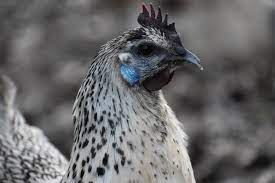
Another distinct feature of a mosaic chicken is its earlobes. Some mosaic chickens develop iridescent turquoise earlobes, which are most prominent in roosters. These are vibrant and unique to this breed.
Weight
In terms of size, the mosaic chickens are medium-sized. Mosaic roosters are heavier and bulkier than most other chicken breeds. And they weigh around 8 – 8.5 lbs. Hens are smaller and they weigh around 6 – 6.5 lbs.
There’s a bantam variety for mosaic chickens too. The bantams are smaller than the normal mosaic chickens. Bantam roosters weigh anywhere between 1 – 1.2 lbs, while the hens weigh 0.7 – 0.9 lbs.
Mosaic Chicken Personality & Temperament
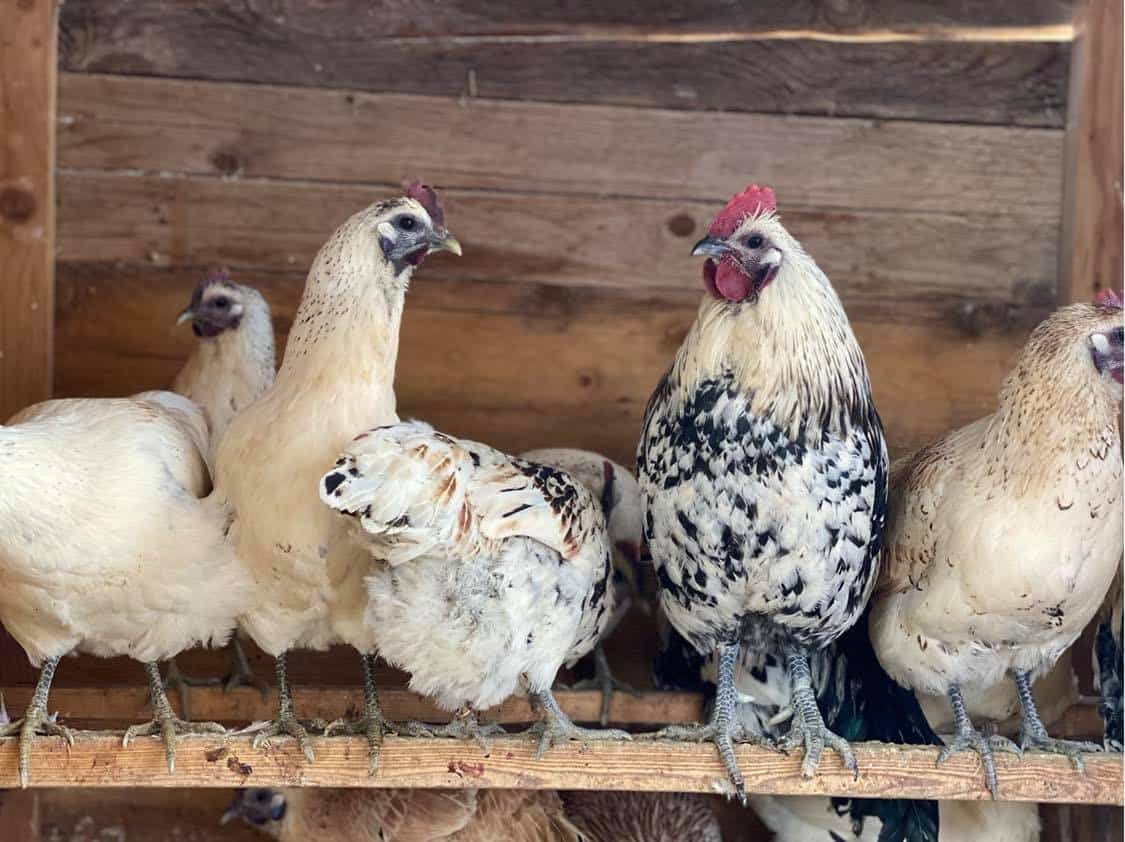
When it comes to personality and temperament, a mosaic chicken is truly a farmer’s dream! This stunning chicken is gentle, calm, and friendly.
It socializes well within its flock and with other breeds. In fact, some poultry keepers even say it needs to mingle with other chickens. If kept alone, a mosaic chicken may die of loneliness.
They demand less attention but tend to enjoy the company of humans. They’re harmless to kids as well!
However, the gentle nature of this chicken also makes it prone to bullying. So, be careful when merging mosaic chicken flocks with aggressive chickens like Asil or Thai Gamefowl. The mosaics may get pecked on.
Apart from that, mosaic chickens possess great predator awareness. And hence, they have a great sense of how to detect and deflect predators and threats. They’re likely to alert the flock timely.
Their different colored mosaic patterns also give them an advantage. It helps them camouflage and protect themselves from predatory attacks.
What’s more, as its owner, you won’t find yourself annoyed with the chickens’ dumbness or distant behavior. They’re intelligent creatures and so, you’d be pleased with how self-sufficient and docile they are.
You can leave a mosaic chicken freely in your backyard or unguarded farm. They’re great free rangers and will enjoy their time scavenging and hunting for food and fun!
But if you cannot afford to keep them free and need to confine them, make sure you dedicate three square feet of space per bird. Usually, the more, the merrier.
Compact and inadequate rooms can lead to the growth of bacteria and bugs, particularly if you’re keeping many of these chickens (such as in the case of poultry farms).
Mosaic Chicken Egg-laying
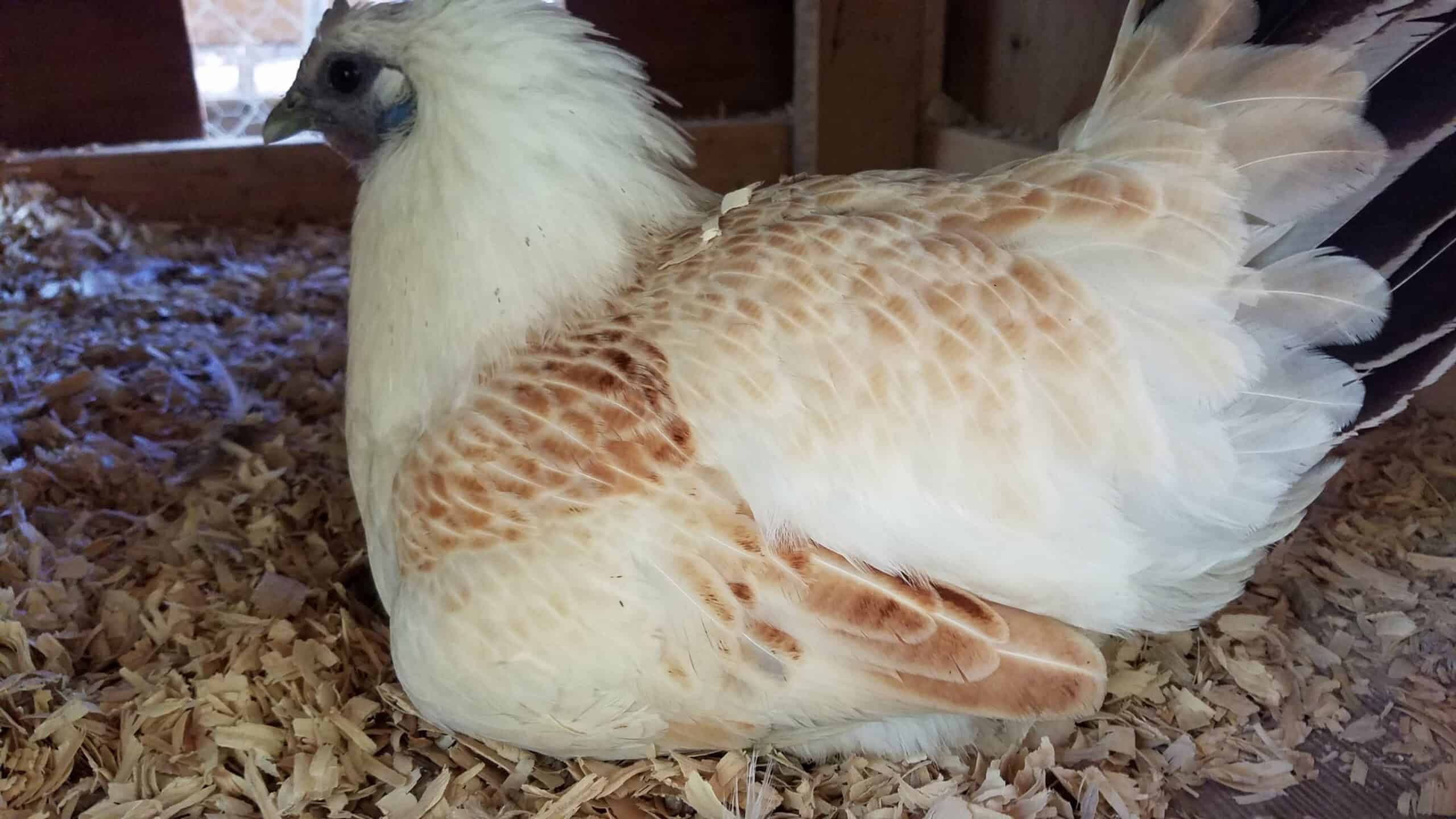
Apart from enhancing the feel and looks of your farm, mosaic chickens are also an excellent pick for egg-laying. These chickens lay a good number of eggs annually, ranging from 200 eggs to 250 eggs.
Some smaller-sized mosaic chickens may lay 150 eggs per year. But it doesn’t get any lower than that!
The appearance of the eggs is also fair and fine. Contrary to popular belief, their eggs are not black or gray. Instead, they are spotless and cream-colored.
The chickens conveniently lay eggs all around the year. But in summer, their egg-laying frequency may reduce due to heat stress.
Moreover, the composition of their eggs is strong and nutritious. If you decide to sell the eggs of a mosaic chicken, you might earn $5 – $10 per egg.
As for broodiness, there’s a disputed opinion on whether the breed is broody or not. Some poultry experts claim that the mosaic chicken is not broody at all and you can easily collect the eggs.
Some say the mosaic hen is fiercely broody. Perhaps, their broody nature truly varies from chicken to chicken – just like their color patterns.
But on a general note, it’s safe to say that the chicken is moderately broody given its gentle nature.
It’s worth noting that egg production lowers in mosaic chickens with age. A five-year-old mosaic chicken will not give you as many eggs as a two-year-old chicken. Its production might lower to 150-180 eggs per year.
With that said, mosaic chickens are an excellent pick for those who are only starting out their journey in the poultry world. They are fairly good layers and breeders. They offer a steady supply of eggs throughout the year.
Meat Profile of Mosaic Chicken
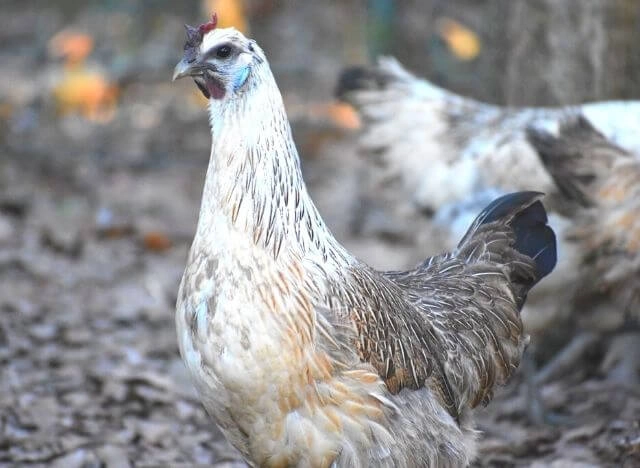
Similar to its eggs, the meat of a mosaic chicken is also top-notch quality. It’s usually juicier and tender as compared to the very popular Leghorn.
Its meat also contains less fat, which makes the mosaic chicken a health-friendly option for people vulnerable to heart issues.
From a business perspective, meat production per chicken is also profitable. It’s slightly more than the commercial chicken and the price you get per ounce is much higher.
End Note
By now, we hope you’re well aware of how unique and fascinating the mosaic chicken happens to be. Although this chicken breed is not yet officially recognized by the American Poultry Association as an official breed standard, its popularity is still increasing with a steep slope. It might soon be recognized!
If you’re planning to keep a mosaic chicken, make sure you weigh the pros and cons as per the characteristics given above. Also, bear in mind, raising mosaic chickens and mosaic baby chicks is not that easy. These chickens are high maintenance in terms of cleaning. If you fail to keep the coop clean, they might develop severe infections and health issues.

